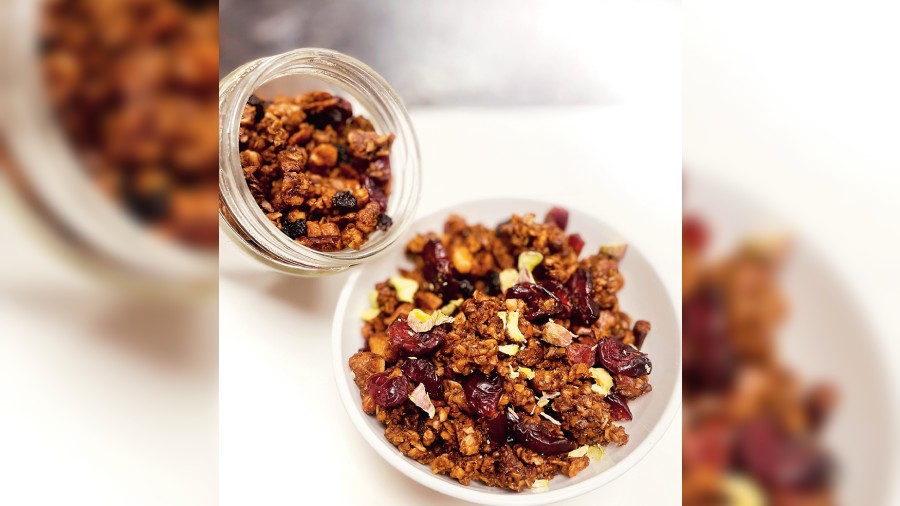Today is Mahalaya. At the outset, let me start by wishing all my readers a very happy and prosperous festive season ahead, may the Mother Goddess honour our invite and visit our homes this year again and bring all of us unlimited joys, great health, empathy for all and lots and lots of good food. In many ways, today’s day is the bellwether for the upcoming festive season, most anticipated among those being the grand festival of Durga Puja, for which worshippers across the world, specially Bengalis, wait the entire year. Growing up in a small city in Western UP, I had always heard of the grandeur and surrealism of the ‘Pujo’ of Kolkata from my Bengali friends, of whom I had very few, and could vaguely picture how it might be. Those days, in absence of the tell-all gadgets and information overload of today, we kids had nurtured a strong power of imagination and we could see and feel things based on stories and hearsay. In that context, and having been to the solitary Durga Puja in that city, I had somewhat of an inkling as to what the Durga Puja might feel like.
Cut to 1997 and I was witness to the first proper Durga Puja celebrations of my life and I have to say, I was not prepared, in my wildest dreams to see what I was seeing unfold. It was as if all the festive gatherings I had seen in all my life, of all festivals, of the biggest fairs, circuses and celebrations, put together and multiplied many times over, was minuscule compared to the grandeur, enthusiasm and the sheer magnitude of the celebrations of those five days. Over the years, I’ve had a chance to travel to different parts of the world, and be able to participate in some renowned street festivals and carnivals such as the famed Rio de Janeiro carnival, the Mardi Gras of New Orleans and the Oktoberfest of Munich but these are insignificant compared to what Kolkata witnesses, and I’m not exaggerating at all. While people in Bengal might not think too much about this, since we see it every year, my readers from outside the state would certainly want to envisage the splendour, magnificence and glory of this bewildering display of stunning creativity, staggering bonhomie and astounding scale.
While many festivals across the world are celebrated by more people than our Durga Puja, I can say with confidence that none of the others have evolved into a grand social celebration, irrespective of religion, ethnicity, gender or creed the way Durga Puja has. It is an unbridled celebration of the Goddess of power amalgamated with sombre piety and the majestic five-day festivities, most characterised by good food, family get-together and practice of art forms by one and all. Talking about food, Durga Puja is also unique in the fact that many households do minimum or no cooking on those five days of celebrations and people gorge on all kinds of foods, for all meal periods that are either prepared in community kitchens or outsourced, especially for the subscribers of the thousands of Puja committees, which is almost all the people.
While most of our Indian festivals have some unique culinary dishes earmarked for that particular festival through tradition, Durga Puja is one festival that observes no difference between the culinary heritage of the food items or their traditional consumer groups. It is as popular to have a biryani as it is to have a chicken roll, kosha mangsho, a fish paturi or even the ubiquitous paani poori or the mother of all Indo-oriental street food — the veritable chowmein. Most people of the current generation would remember the festivities of Durga Puja through the varied culinary experiences, a part and parcel of the celebrations. While I have said earlier that it is increasingly becoming common for people to not cook at home during the festivities, through this column I would try reimagining some of the quintessential Durga Puja favourite street foods into simple recipes that can be made and shared during the Puja celebrations. After all, there is nothing as lovingly personal than to cook for people you love, as far as I am concerned. So here goes:
Granola “Jhalmuri”
The simple, unassuming but flavour-packed jhalmuri is a staple during the Durga Puja festivities, especially around the Puja pandals that multitudes of people frequent during this time. Here is my healthier take on the same. This also makes for a nutritious, savoury-sweet bar snack and is quite handy for controlling overeating of unhealthy snacks at parties. I also like to carry a small jar of this in my car and have a mouthful whenever hunger pangs hit, including during the pandal-hopping spree.
INGREDIENTS
- Oatmeal: 100g
- Honey: 50ml
- Ghee: 50g
- Jaggery powder: 50g
- Cashew nuts, walnuts, almonds, pistachio, cranberry, raisins, melon seeds: 25g each
- Chat masala, black salt, chilli powder, and black pepper powder: a pinch each
METHOD
Mix oatmeal, honey, jaggery and ghee. Spread on a baking sheet and bake it for 15 minutes at 180C. Cool slightly and break into small clumps, add the nuts and spices and put back into the oven at the same temperature for the same time. Cool and store airtight. Can last up to six months.
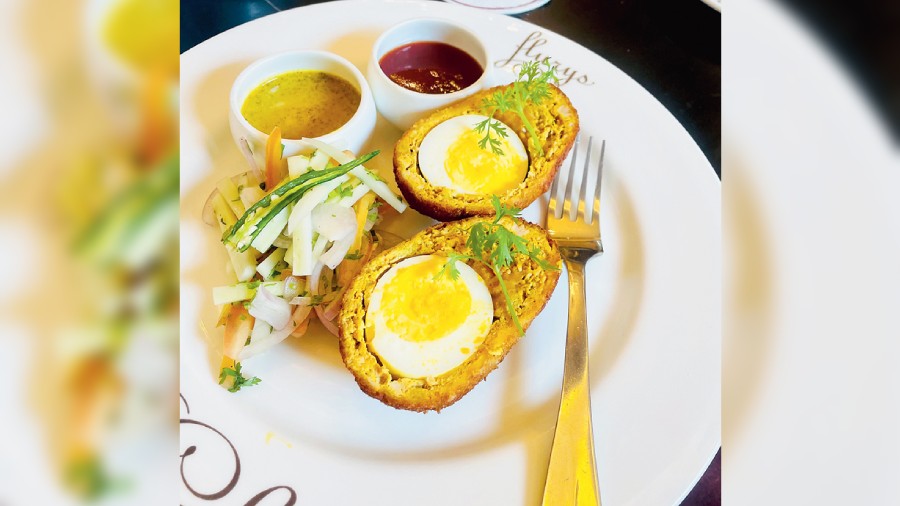
Scotch “Dimer Devil”
Another very popular Durga Puja snack that somehow appears around the food stalls in the city around this time of the year is the curiously named dimer devil and many other variations of deep-fried cutlets called ‘chops’. While this dish has its origins in the British India kitchens and is said to have been named after the famous ‘devilled eggs’, the dish itself is unique in its interesting variability of textures, portability of preparation and in being a please-all dish that can be had on the go. A distant cousin of the ‘dimer devil’ is the Scotch egg, a similar preparation of deep-fried, crumbed boiled eggs but with a coating of meat instead of spiced potato mash. These go very well with a dash of the pungent kasundi and are an anytime snack. These can also be made in advance, stored in the refrigerator and fried as required.
INGREDIENTS
- Boiled Eggs: 4
- Chicken mince: 200g
- Salt, pepper, mustard powder: a pinch of each
- Parsley, coriander: 10g each chopped
- Bread crumbs: 100g
- Egg: 2
- Milk: 100ml
- Oil: For deep frying
METHOD
Mix the chicken mince with seasonings and herbs and knead well. Divide into 4 equal parts. Cover each egg with the chicken mince, coat in the batter of egg and milk, cover well with bread crumbs and deep-fry in hot oil until golden. Serve with kasundi and salad.
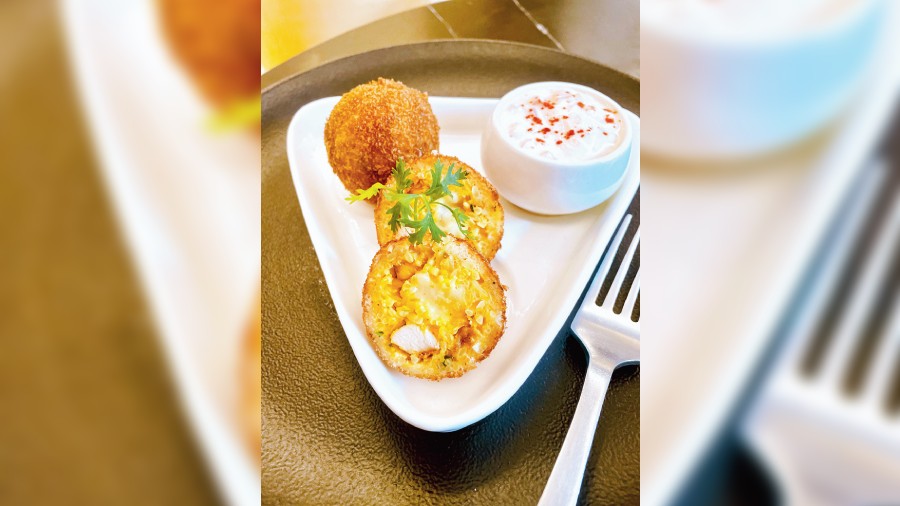
Mutton Biryani ‘Arancini”
There is no clear understanding of how biryani came to be synonymous with the Durga Puja cuisine culture, but this is true that the Kolkata biryani is among the most sought-after food items served and sold during the Pujas. Almost all Puja pandal food courts serve this dish, so much so even the restaurants and food establishments that do not ordinarily make or serve biryani on their regular menus do so during the days of the Puja. Many times, especially while ordering overzealously for house parties, biryani remains as a leftover and while they taste very nice reheated, where’s the fun in that? Here I give a recipe for a biryani mash-up based on the famous Italian dish arancini, which is made often in Italian households with leftovers of their famed rice dish called risotto, a distant, distant cousin of the biryani.
INGREDIENTS
- Leftover biryani: 500g (debone the meat and shred into small pieces, mix back in the biryani)
- Deep-fried onions: 50g
- Fresh mint and coriander: 20g chopped
- Mozzarella cheese: 100g, cut into rolling dice-sized cubes
- Eggs: 2
- Milk: 100ml
- Bread crumbs: 100g
- Oil: For deep-frying
- For the raita dip
- Sour yoghurt: 100g
- Chopped fresh mint: 20g
- Garlic paste: 5g
- Salt
- Roasted powdered cumin, red chilli powder: to taste
METHOD
Mix the biryani, fried onions and herbs, mash with hand so that all of it comes together, and add an egg if the mixture is too dry. Roll into small balls, stuff a piece of mozzarella cheese in each and chill. Mix the milk, egg and seasoning. Dip the chilled arancini balls in the egg mix, then coat generously in the bread crumbs. Deep-fry in hot oil till golden brown. Garnish with fried onions, ginger and green chillies and serve hot with a raita dip, made by mixing sour yoghurt with garlic, roasted cumin and chopped mint.
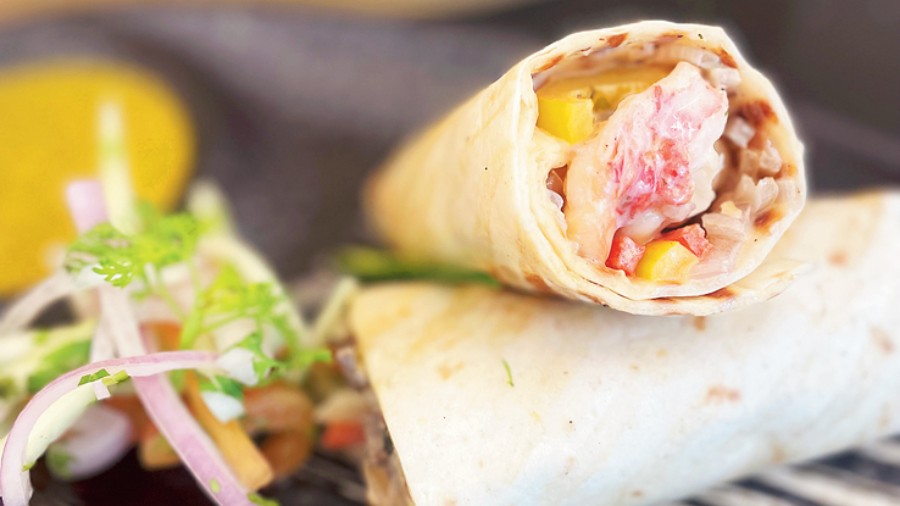
Creamy Prawn ‘Kathi Roll’ with Kasundi
There is no arguing the fact that among all the famous street foods of Kolkata, the most popular by far is its rolls. These handy, snacky concoction of flaky paratha, a meat filling, salad and sauce are among the best examples of culinary creativity and ease of enjoyment. Across the neighbourhoods of Puja pandals all across the city and beyond, the egg/chicken/mutton roll is the first choice of on-the-move food for everyone. Here is my twist to it, fresh prawns are abundantly available this time of the year, and I have modelled this dish around the famous lobster roll, a snack very commonly had in the New Orleans Mardi Gras, the very famous street festival and carnival in the USA.
INGREDIENTS
- Whole-wheat tortilla wraps: 6
- Fresh jumbo prawns: 500g (shelled, cleaned and cut into bite-sized pieces)
- Chopped onion: 50g
- Chopped garlic: 10g
- Fresh cream: 100ml
- Grated processed cheese: 50g
- Salt, pepper: to taste
- Chopped celery, spring onion and parsley: 10g each
METHOD
Saute the onion and garlic, add the shelled prawns and saute briefly, for approx 2 minutes on high heat. Lower the heat to medium, and add the cream, cheese and herbs. Take off the heat.
Grill/pan-fry the tortilla wraps, spread a generous layer of the prawn mixture, drizzle with kasundi or mustard paste, add shredded capsicum, onion and a dash of lemon if desired, roll up, cut into halves and serve.
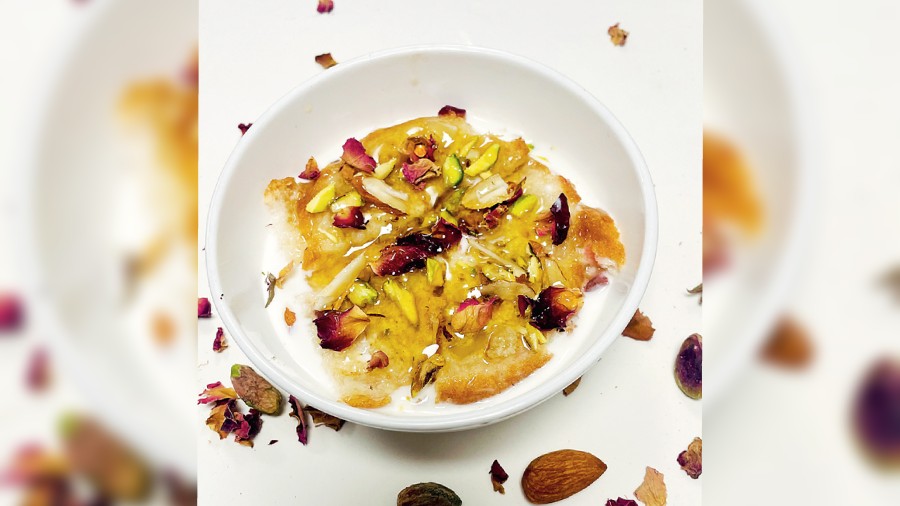
Malpua, Banana and Rose Petals Pudding with Honey
The famous Indian sweet malpua, banana and honey are said to be among the most favourite foods of Goddess Durga and are offered to her different forms of Kushmanda, Skandmata and Katyani as bhog on fourth, fifth and sixth days of the nine-day pujas. I am sharing the recipe of a dessert that can be had warm or cold and can be made ahead and stored in the refrigerator for a week. It can go very well as a filling for a tart also.
INGREDIENTS
- Malpua: 500g
- Malpua syrup: 100ml
- Milk: 300ml
- Cream: 100ml
- Condensed milk: 200ml
- Fresh mashed banana: 100g
- Gulkand: 20g
- Honey: 50g
- Fresh rose petals, and chopped nuts: for garnish
METHOD
Boil the milk, cream and condensed milk together. Add the mashed banana, syrup and gulkand. Cut the malpua into small pieces. Layer the malpua in the bottom of a baking dish and sprinkle with some dry fruits. Pour over the prepared milk mix and soak for 1 hour. Bake in a preheated oven for 30 minutes at 180C. Sprinkle with chopped pistachio, fresh/dried rose petal, almonds and honey. Serve warm or cold.
Pictures courtesy the author

Vikas Kumar is the executive chef of Flurys. You can reach him at vkumar@flurys.com
